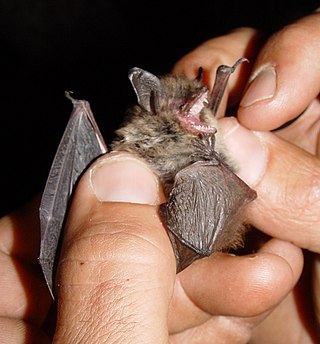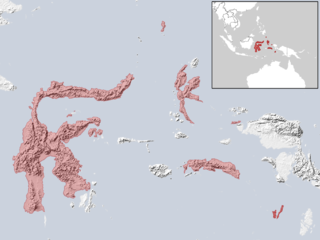
The mouse-eared bats or myotises are a diverse and widespread genus (Myotis) of bats within the family Vespertilionidae. The noun "myotis" itself is a Neo-Latin construction, from the Greek "muós and "oûs", literally translating to "mouse-eared".

The eastern long-fingered bat, or big-footed myotis is a species of vesper bat found in China, Japan, North Korea, South Korea, and Russia. Roosting in caves and rock crevices during the day, it forages at night for insects near rivers and streams.

The large-footed bat, large-footed mouse-eared bat, or large-footed myotis is a species of vesper bat. It can be found in the following countries: Australia, Indonesia, Malaysia, Papua New Guinea, Singapore, Solomon Islands, Taiwan, Vanuatu, and possibly Vietnam.

The southwestern myotis is a species of vesper bat. It is found in Guatemala, Mexico, and the United States.

The Australian myotis is a species of vesper bat. It is found only in Australia. This taxa may not represent a valid species. Only one specimen has ever been documented, supposedly from New South Wales. This specimen may have been mislabelled or a vagrant Myotis muricola or Myotis ater.

The western small-footed bat, also known as the western small-footed myotis, is a species of vesper bat native to North America.

The fringed long-footed myotis is a species of vesper bat in the family Vespertilionidae. It is found in China, Taiwan and Hong Kong.

The eastern small-footed bat is a species of vesper bat. It can be found in southern Ontario and Quebec in Canada and in mountainous portions of the eastern United States from New England to northern Georgia, and westward to northern Arkansas. It is among the smallest bats in eastern North America and is known for its small feet and black face-mask. Until recently, all North American small-footed Myotis were considered to be "Myotis leibii". The western population is now considered to be a separate species, Myotis ciliolabrum. The Eastern small-footed bat is rare throughout its range, although the species may be locally abundant where suitable habitat exists. Studies suggest white-nose syndrome has caused declines in their populations. However, most occurrences of this species have only been counted within the past decade or two and are not revisited regularly, making their population status difficult to assess. Additionally, most bat populations in the Eastern U.S. have been monitored using surveys conducted in caves and mines in the winter, but Eastern small-footed bats hibernate in places that make them unlikely to be encountered during these surveys. Perhaps as a result, the numbers of Eastern small-footed bats counted in winter tend to be low and they are relatively variable compared to other species of bats. Many biologists believe the species is stable, having declined little in recent times, but that it is vulnerable due to its relatively restricted geographic range and habitat needs.

Rickett's big-footed bat is a species of vesper bat. It can be found in southern and eastern China, Vietnam, and Laos. This species has often been called Myotis ricketti, but the older M. pilosus has priority. The erroneous reporting of the type locality as being in Uruguay by Wilhelm Peters led to the dual naming.

The fringed myotis is a species of vesper bat that is found in British Columbia, Mexico, and the western United States.

The California myotis is a species of vesper bat. It is found in British Columbia in Canada, Guatemala, Mexico, and in the western United States, including California.

The large myotis is a species of vesper bat. It is found in central and southeast China, Hong Kong, Myanmar, Thailand, and northern Vietnam. It is also expected to occur in northern Laos, but not yet documented there.

The southern myotis, also known as large-footed myotis, is a species of vesper bat (Vespertilionidae) in genus Myotis. The southern myotis is one of only two Australian "fishing" bats and feeds by trawling its specially adapted feet along the water's surface for aquatic invertebrates and fish.

David's myotis is a species of microbat in the Vespertilionidae family native to China, Mongolia, Kazakhstan, and Russia. First identified in 1869 by Wilhelm Peters, it is similar in morphology to species like M. mystacinus, M. ikonnikovi, M. brandtii, and M. sibiricus. It was previously considered to be a subspecies of the whiskered bat.

The Maluku myotis, also commonly known as the Arafura large-footed bat, is a species of mouse-eared bat. Native to Indonesia, and possibly New Guinea and northern Australia, it one of several species known as "fishing bats" because they catch their prey on the surface of water, scooping it up with their large feet.
The Barbados myotis is a species of bat found in the Lesser Antilles. It was previously considered a subspecies of Schwartz's myotis, Myotis martiniquensis, but was elevated to species rank in 2012.

The cryptic myotis is a European vespertilionid bat. It is a member of the Natterer's bat species complex, and is also the closest living relative of M. nattereri. It is mostly distributed across European countries bordering the Mediterranean Sea, from Spain west to Austria, north to Switzerland, and south to most of the Italian Peninsula. Populations of similar bats in southern Italy and Sicily display significant genetic divergence from M. crypticus, and thus may represent a unique taxonomic entity that requires more study. It is found in a wide range of altitudes, from sea level to 1000 meters above. It feeds in forest and grassland habitats and roosts in tree hollows as well as man-made structures. In autumn, M. crypticus swarms with other Myotis in large numbers, and overwinters with them in underground sites such as crevices.

















